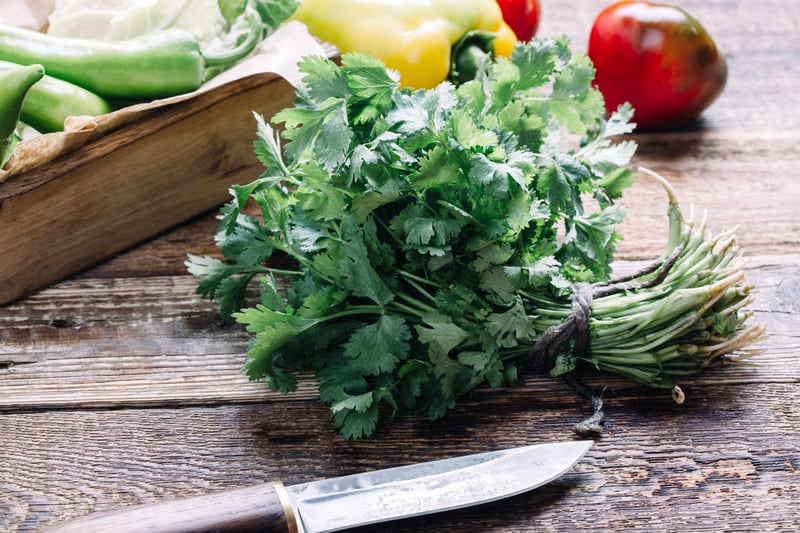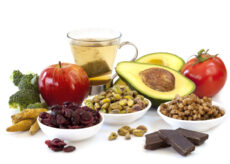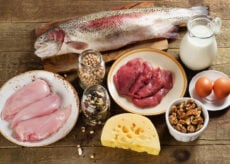What Your Food Preferences Say About Your DNA & Genes

When it comes to the foods we like or steer away from, there are many factors. For example, we tend to prefer familiar foods, like those we grew up with. Our cultures and environments have a big impact. So can our health, daily diets, and habits. Food preferences can also differ due to age, sex, economic status, and food availability. Yet there’s another surprising factor that’s gaining attention: our genetics. Indeed, our genes can alter how we perceive the foods we eat (aka, our “sensory perception”). This includes the taste and smell of foods.
While much of the research is still emerging, there’s evidence that our DNA can play a role in the foods we naturally like or dislike. 1 So, if you hate the taste of Brussel sprouts, love cilantro in your salsa, or find honey too sweet, for example, it may be because of your genes, at least partly.
This is because we have specialized receptors in the tongue and nose that respond to the foods we eat. They’re highly attuned to specific nutrients and aromas. For example, we have receptors that only detect sweetness, not bitterness. In contrast, we have receptors that only detect bitterness and not sweetness.
The brain takes the signals from those specialized receptors and determines the flavor. But first, it also checks in with other influences, such as the heat from chilis, the creaminess of Greek yogurt, etc.
There are currently 35 known receptors found in human tongues that detect flavor profiles. These flavors include:
- Sweet
- Salty
- Bitter
- Sour
- And umami (i.e., savory “meaty” flavors)
On top of that, there are around 400 receptors in our noses to detect smells or aromas. 2 And genetic differences explain why flavors can be so uniquely experienced. Different people, for example, may vary by 30 to 40% genetically when it comes to these receptors. In other words, because our DNA encodes instructions for the receptors, different people can experience tastes very differently. This can explain why your best friend can’t get enough of the cilantro-loaded salsa, while you want to rinse your mouth out immediately after one bite (if it even makes it that far).
Genes and Your Taste Preferences
Sensing Sweetness
According to research with twins, the perception of the sweet taste of sugar and other sweeteners is at least partly due to our genes. Two have been found by researchers to detect the intensity of sweetness (TAS1R2 and TAS1R3). 3 – 5 Interestingly, age is also a factor with children preferring more sweet flavors while their mothers gravitate to foods that are creamier (i.e., higher in fat and lower in sugar). 6
Battling the Bitter
Humans also have taste receptors tuned to bitter flavors. Researchers have found there are two groups: those who are tasters and those who are non-tasters, based on their ability to detect bitter flavors. Tasters have been found to find bitter compounds 60% more bitter than non-tasters. 7 And around 30% of the population doesn’t taste these flavors at all (i.e., they’re taste blind). 8
It makes sense that we have bitter receptors (e.g., TAS2R38), and they were once believed to stop us from eating vegetables that were toxic. That said, this theory is often debated.
Whatever the reason, some of the healthiest foods are also high in bitter compounds. Tasters tend to be more likely to steer away from brassica or cruciferous vegetables (e.g., arugula, broccoli, cabbage, kale, radishes, and Swiss chard) and other foods they find bitter, including watercress, mustard greens, turnips, rutabaga, horseradish, grapefruit, beer, and coffee. 8, 9 These tasters also appear to gravitate more toward fatty foods and to better tolerate hot foods like chili peppers. 8
Unfortunately, if you do find yourself avoiding certain healthy vegetables because of their bitter flavor and instead favor more fatty foods, you can also increase your risk of obesity, type 2 diabetes, and other health problems. 10 – 12
A Tale of Two Salsas
One herb is well-known for being highly contentious. That is Coriandrum sativum, better known as cilantro or coriander. This herb is used by cultures around the world. But it can also make your potluck more polarizing with some guests raving over your homemade salsa and others grumbling that it tastes foul—like dirt or, more commonly, soap.
The preference, or lack thereof, for this herb appears to have a genetic component. However, it actually is related to how the food smells (rather than receptors on the tongue). And it’s more common for people whose ancestry is European than from other areas. 13
So, if someone puts their nose up when you serve your salsa, don’t take it personally. It all has to do with their olfactory receptors rather than your family recipe.
Can You Learn to Like Certain Foods?
The answer for some foods is likely no. For example, the people who think cilantro has a soapy flavor likely won’t change. However, with most foods, it is possible to learn to like it as genetics only play a small role.
RELATED: How to Get Keto Results WITHOUT the Keto Diet
Instead of giving up on bitter or sour foods, for example, try these easy adjustments to increase your dietary variety:
• Eat more of it: Just by increasing your exposure to certain foods, you’ll start to like them more. Plus, many of us outgrow childhood favorite foods, and as we get older, we tend to better tolerate bitter flavors like broccoli and mixed greens. So, keep putting these foods on your plate and you’ll gradually begin to enjoy them more.
• Spice it up: Foods are rarely eaten alone and are instead included in recipes. This can work in your favor as a combination of spices can help mask bitter or sour flavors, such as in this yummy vegetarian Thai curry, kale with mustard and apple summer salad, or green chicken curry.
• Cook it a new way: Many people have negative associations with certain foods due to the way they were prepared (remember mushy lunchroom spinach?), only to later find a new love of the food by preparing it in a whole new way. Steamed Brussels sprouts may make you want to send yourself off to your room without dinner, but roasting them with bacon is a whole different story. Sliced avocado on a salad may turn your tongue, but smash it up to smooth over toast (perhaps with an egg) can make your mouth water. Overcooked spinach may lead to nightmares, but you may never even notice when greens are added to chicken and bean stew.
Food Preferences: A Variety of Factors
While some of our genetic food preferences are well-documented, they’re only part of the story. 1 A number of other factors contribute to the foods we enjoy—from our attitudes toward health, age (yes, tastes do change as we get older), personality traits, economic status, and cultural norms. 14 Even early experiences with foods (such as in utero and through breastfeeding) can impact food preferences. 15 So, even if you are, for example, a supertaster who finds bitter foods more, well, bitter, you may still enjoy these foods as you’re used to eating them or they’re part of your cultural background. 8
According to 23andMe (the DNA or genetic data folks), while there’s a genetic component of sweet vs. salty preferences, for example, it’s “not a black and white association.” Rather, people are more likely to lean in that direction, and we need to take a more nuanced approach. Cravings for certain tastes, whether salty, sweet, or bitter (e.g., coffee), may be more of a habit or a cultural norm than an actual genetic trait.
Hormonal shifts can also change how we taste. For example, people who are feeling anxious or depressed may find it harder to distinguish between sour, sweet, and bitter foods due to the lower levels of serotonin in their bodies.
Other factors that lead to food preferences or cravings include nutrient deficiencies, lack of sleep, poor diet, low blood sugar, dehydration, and stress. In other words, while genetics may predispose your preferences for certain foods, lifestyle choices can help you better manage your cravings, so you get a wide range of healthy foods and avoid reinforcing unhealthy eating patterns.
Finally, while there is a genetic component to health, it appears to be only 10% or less. Behaviors, social, and economic factors have a much bigger impact (70% together). That is, your day-to-day choices have a much bigger impact than the genetic hand you were dealt when it comes to following a healthy diet, even if Brussels sprouts never become a favorite food.




 7 Signs Your Body is Seriously Low on Collagen (not just wrinkles)
7 Signs Your Body is Seriously Low on Collagen (not just wrinkles) Health Expert: "Turmeric Doesn't Work (unless...)"
Health Expert: "Turmeric Doesn't Work (unless...)" 3 Warning Signs Your Probiotic Supplement is a Total Waste
3 Warning Signs Your Probiotic Supplement is a Total Waste

